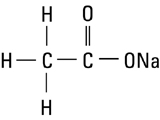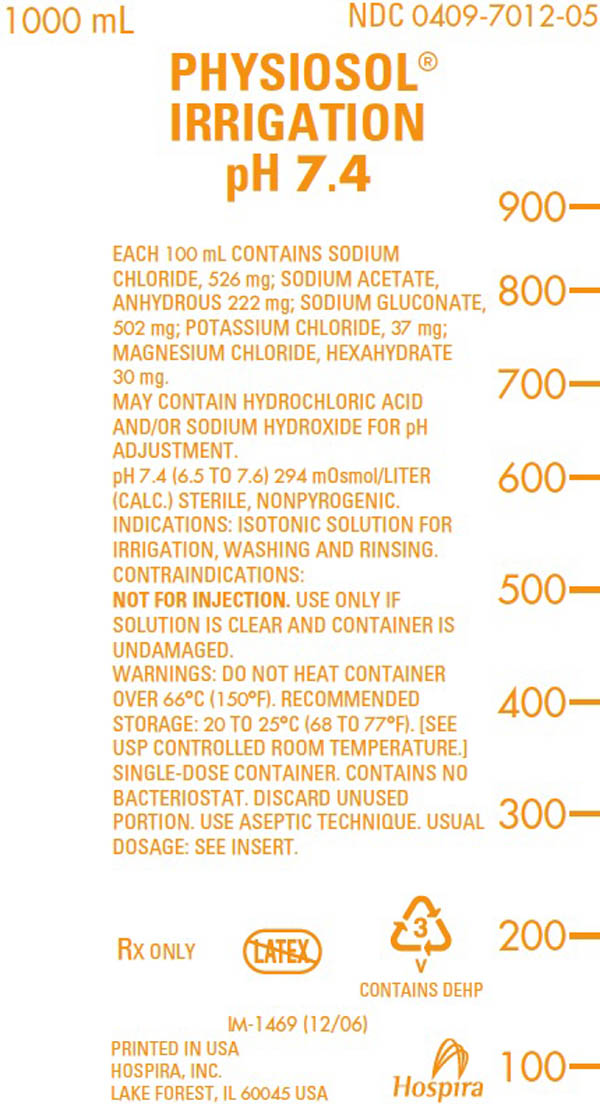PHYSIOSOL
-
sodium chloride,
sodium acetate anhydrous,
sodium gluconate,
potassium chloride and
magnesium chloride irrigant
Hospira, Inc.
----------
Balanced Electrolyte Solution for Irrigation
for all General and Arthroscopic Irrigation, Washing and Rinsing Purposes
Not for Injection
Flexible Irrigation Container
Rx only
DESCRIPTION
PhysioSol® Irrigation pH 7.4 is a sterile, nonpyrogenic solution of electrolytes in water for injection intended only for sterile irrigation, washing and rinsing purposes.
Each 100 mL of PhysioSol Irrigation pH 7.4 contains sodium chloride, 526 mg; sodium acetate, anhydrous 222 mg; sodium gluconate, 502 mg; potassium chloride, 37 mg; magnesium chloride hexahydrate 30 mg. May contain HCl and/or NaOH for pH adjustment. pH 7.4 (6.5 to 7.6).
The solution is isotonic (294 mOsmol/liter, calc.) and has the following electrolyte content (mEq/liter): Na+ 140, K+ 5, Mg++ 3, Cl− 98, HCO3− 50 alternates (27 as acetate and 23 as gluconate).
It contains no bacteriostat, antimicrobial agent or added buffer (except for pH adjustment) and is intended only for use as single-dose or short procedure irrigation. When smaller volumes are required the unused portion should be discarded.
PhysioSol Irrigation pH 7.4 may be classified as a sterile irrigant, wash, rinse and pharmaceutical vehicle.
Magnesium Chloride, USP is chemically designated magnesium chloride hexahydrate (MgCl2 •6 H2O), colorless flakes or crystals very soluble in water.
Potassium Chloride, USP is chemically designated KCl, a white granular powder freely soluble in water.
Sodium Chloride, USP is chemically designated NaCl, a white crystalline powder freely soluble in water.
Sodium Acetate, USP is chemically designated sodium acetate (C2H3O2Na), colorless crystals or white crystalline powder or flakes very soluble in water. It has the following structural formula:

Sodium gluconate is chemically designated C6H11NaO7, the normal sodium salt of gluconic acid soluble in water. It has the following structural formula:

Water for Injection, USP is chemically designated H2O.
The flexible plastic container is fabricated from a specially formulated polyvinylchloride. Water can permeate from inside the container into the overwrap but not in amounts sufficient to affect the solution significantly. Solutions inside the plastic container also can leach out certain of its chemical components in very small amounts before the expiration period is attained. However, the safety of the plastic has been confirmed by tests in animals according to USP biological standards for plastic containers.
CLINICAL PHARMACOLOGY
PhysioSol Irrigation pH 7.4 exerts a mechanical cleansing action for sterile irrigation of body cavities, tissues or wounds, indwelling urethral catheters and surgical drainage tubes, and for washing, rinsing or soaking surgical dressings, instruments and laboratory specimens. It also serves as a vehicle for drugs used for irrigation or other pharmaceutical preparations.
PhysioSol Irrigation pH 7.4 is useful as an irrigant of body joints because the pH and electrolyte composition of the solution approximates that of synovial fluid. Additionally, it provides a transparent fluid medium with optical properties suitable for good visualization of the interior joint surface during endoscopic examination. During arthroscopic surgical procedures, the solution acts as a lavage for removing blood, tissue fragments and bone fragments.
PhysioSol Irrigation pH 7.4 provides an isotonic calcium-free balanced electrolyte irrigation with the same ionic composition as Normosol®-R, pH 7.4, a multiple electrolyte solution for I.V. replacement of acute extracellular fluid losses.
PhysioSol Irrigation pH 7.4 is considered generally compatible with living tissues and organs.
Magnesium chloride in water dissociates to provide magnesium (Mg++) and chloride (Cl−) ions. Magnesium is the second most plentiful cation of the intracellular fluids. It is an important cofactor for enzymatic reactions and plays an important role in neurochemical transmission and muscular excitability. Normal plasma concentration ranges from 1.5 to 2.5 or 3.0 mEq/liter. Magnesium is excreted solely by the kidney at a rate proportional to the plasma concentration and glomerular filtration.
Potassium chloride in water dissociates to provide potassium (K+) and chloride (Cl−) ions. Potassium is the chief cation of body cells (160 mEq/liter of intracellular water). It is found in low concentration in plasma and extracellular fluids (3.5 to 5.0 mEq/liter in a healthy adult). Potassium plays an important role in electrolyte balance.
Normally about 80 to 90% of the potassium intake is excreted in the urine; the remainder in the stools and to a small extent, in the perspiration. The kidney does not conserve potassium well so that during fasting or in patients on a potassium free diet, potassium loss from the body continues resulting in potassium depletion.
Sodium Chloride in water dissociates to provide sodium (Na+) and chloride (Cl−) ions. Sodium (Na+) is the principal cation of the extracellular fluid and plays a large part in the therapy of fluid and electrolyte disturbances. Chloride (Cl−) has an integral role in buffering action when oxygen and carbon dioxide exchange occurs in the red blood cells. The distribution and excretion of sodium (Na+) and chloride (Cl−) are largely under the control of the kidney which maintains a balance between intake and output.
Sodium acetate provides sodium (Na+) and acetate (CH3COO−) ions, the latter anion (a source of hydrogen ion acceptors) serving as an alternate source of bicarbonate (HCO3−) by metabolic conversion in the liver. This has been shown to proceed readily even in the presence of severe liver disease. Thus, acetate anion exerts a mild systemic antiacidotic action that may be advantageous during fluid and electrolyte replacement therapy.
Sodium gluconate provides sodium (Na+) and gluconate (C6H11O7−) ions. Although gluconate is a theoretical alternate metabolic source of bicarbonate (HCO3−) anion, a significant antiacidotic (alkalizing) action has not been established. Thus, the gluconate anion serves primarily to complete the cation-anion balance of the solutions.
Water is an essential constituent of all body tissues and accounts for approximately 70% of total body weight. Average normal adult daily requirement ranges from two to three liters (1.0 to 1.5 liters each for insensible water loss by perspiration and urine production).
Water balance is maintained by various regulatory mechanisms. Water distribution depends primarily on the concentration of electrolytes in the body compartments and sodium (Na+) plays a major role in maintaining physiologic equilibrium.
INDICATIONS AND USAGE
PhysioSol Irrigation pH 7.4 is indicated for all general irrigation, washing and rinsing purposes which permit use of a sterile, nonpyrogenic electrolyte solution.
PhysioSol Irrigation pH 7.4 is also indicated for use as an arthroscopic irrigating fluid with endoscopic instruments during arthroscopic procedures requiring distention and irrigation of the knee, shoulder, elbow or other bone joints. This solution is not indicated for use with electrosurgical instruments.
CONTRAINDICATIONS
NOT FOR INJECTION.
An electrolyte solution should not be used for irrigation during electrosurgical procedures.
WARNINGS
FOR IRRIGATION ONLY. NOT FOR INJECTION.
Irrigating fluids have been demonstrated to enter the systemic circulation in relatively large volumes, thus, those irrigations must be regarded as a systemic drug. Absorption of large amounts can cause fluid and/or solute overloading resulting in dilution of serum electrolyte concentrations, overhydration, congested states or pulmonary edema.
The risk of dilutional states is inversely proportional to the electrolyte concentrations of administered parenteral solutions. The risk of solute overload causing congested states with peripheral and pulmonary edema is directly proportional to the electrolyte concentrations of such solutions.
Do not heat container over 66°C (150°F).
PRECAUTIONS
Do not administer unless solution is clear and container is undamaged. Discard unused portion.
Caution should be observed when a solution is used for continuous irrigation or allowed to “dwell” inside body cavities because of possible absorption into the blood stream and the production of circulatory overload.
Aseptic technique is essential with the use of sterile solutions for irrigation of body cavities, wounds and urethral catheters or for wetting dressings that come in contact with body tissues.
When used for irrigation via irrigation equipment, the administration set should be attached promptly. Unused portions should be discarded and a fresh container of appropriate size used for the start-up of each cycle or repeat procedure. For repeated irrigations of urethral catheters, a separate container should be used for each patient.
Drug Interactions
Additives may be incompatible. Consult with pharmacist, if available. When introducing additives, use aseptic technique, mix thoroughly and do not store.
Pregnancy Category C. Animal reproduction studies have not been conducted with this solution. It is also not known whether it can cause fetal harm when administered to a pregnant woman or can affect reproduction capacity. It should be given to a pregnant woman only if clearly needed.
Pediatric Use. The safety and effectiveness of PhysioSol Irrigation pH 7.4 have not been established. Its limited use in pediatric patients has been inadequate to fully define proper dosage and limitations for use.
Geriatric Use. Clinical studies of PhysioSol Irrigation have not been performed to determine whether patients over 65 years respond differently from younger subjects. Other reported clinical experience has not identified differences in responses between elderly and younger patients. In general, dose selection for an elderly patient should be cautious, reflecting the greater frequency of decreased hepatic, renal, or cardiac function, and of concomitant disease or other drug therapy.
This drug is known to be substantially excreted by the kidney, and the risk of toxic reactions to this drug may be greater in patients with impaired renal function. Because elderly patients are more likely to have decreased renal function, care should be taken in dose selection, and it may be useful to monitor renal function.
ADVERSE REACTIONS
Possible adverse effects arising from the irrigation of body cavities, tissues, or indwelling catheters and tubes are usually avoidable when proper procedures are followed. Displaced catheters or drainage tubes can lead to irrigation or infiltration of unintended structures or cavities. Excessive volume or pressure during irrigation of closed cavities may cause undue distension or disruption of tissues. Accidental contamination from careless technique may transmit infection.
Should any adverse reaction occur, discontinue the irrigant, evaluate the patient, institute appropriate therapeutic countermeasures and save the remainder of the fluid for examination if deemed necessary.
OVERDOSAGE
In the event of overhydration or solute overload, re-evaluate the patient and institute appropriate corrective measures. See WARNINGS, PRECAUTIONS and ADVERSE REACTIONS.
DOSAGE AND ADMINISTRATION
The dose is dependent upon the capacity or surface area of the structure to be irrigated and the nature of the procedure. When used as a vehicle for other drugs, the manufacturer’s recommendations should be followed.
Some opacity of the plastic due to moisture absorption during the sterilization process may be observed. This is normal and does not affect the solution quality or safety. The opacity will diminish gradually.
Parenteral drug products should be inspected visually for particulate matter and discoloration prior to administration, whenever solution container permits. See PRECAUTIONS.
HOW SUPPLIED
PhysioSol Irrigation pH 7.4 is supplied in a single-dose 1000 mL flexible irrigation container (List No. 7012).
Exposure of pharmaceutical products to heat should be minimized. Store at 20 to 25°C (68 to 77°F). [See USP Controlled Room Temperature.]
Revised: January, 2005
©Hospira 2005 EN-0820 Printed in USA
HOSPIRA, INC., LAKE FOREST, IL 60045 USA
| PHYSIOSOL
sodium chloride, sodium acetate anhydrous, sodium gluconate, potassium chloride, and magnesium chloride irrigant |
|||||||||||||||||||||
|
|||||||||||||||||||||
|
|||||||||||||||||||||
|
|||||||||||||||||||||
|
|||||||||||||||||||||
|
|||||||||||||||||||||
| Marketing Information | |||
| Marketing Category | Application Number or Monograph Citation | Marketing Start Date | Marketing End Date |
| NDA | NDA018406 | 07/08/1982 | 08/01/2010 |
| Labeler - Hospira, Inc. (141588017) |
Revised: 06/2012 Hospira, Inc.
